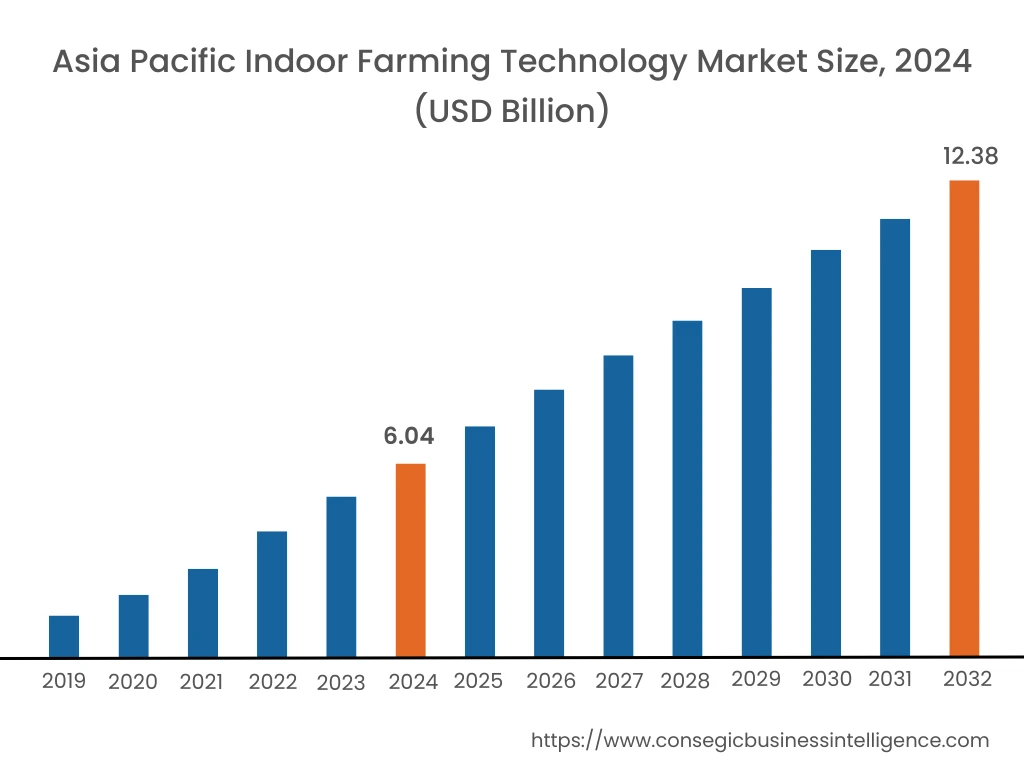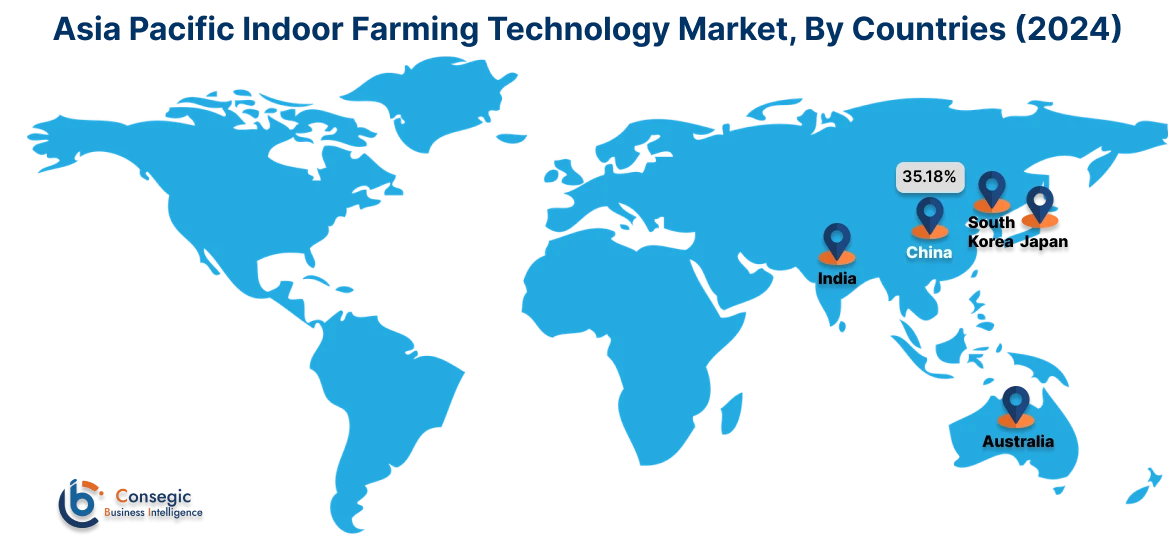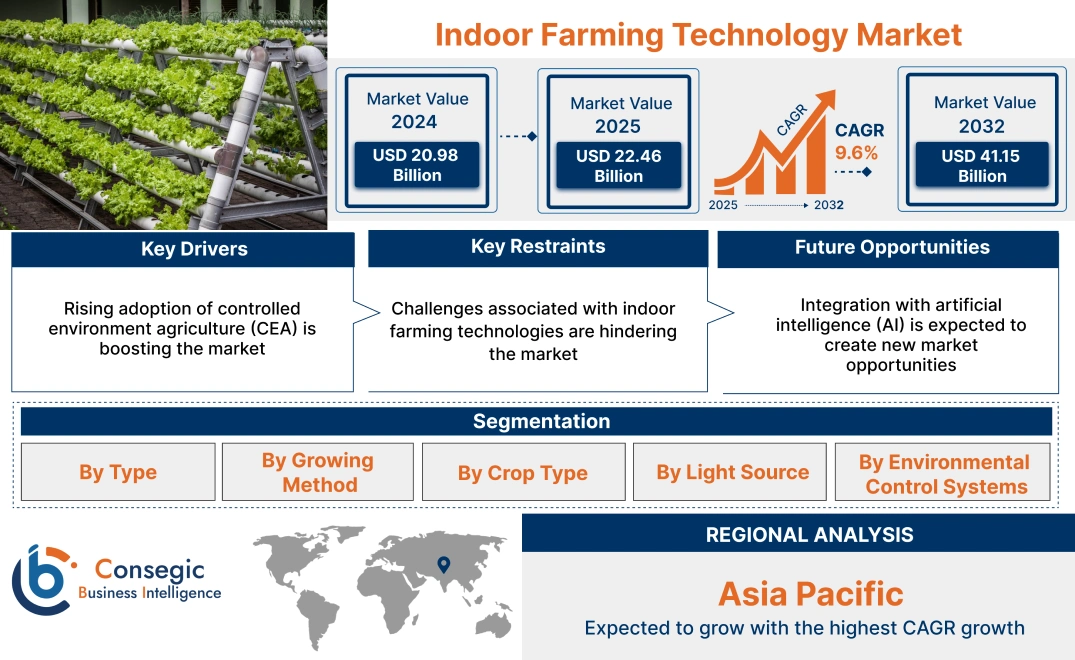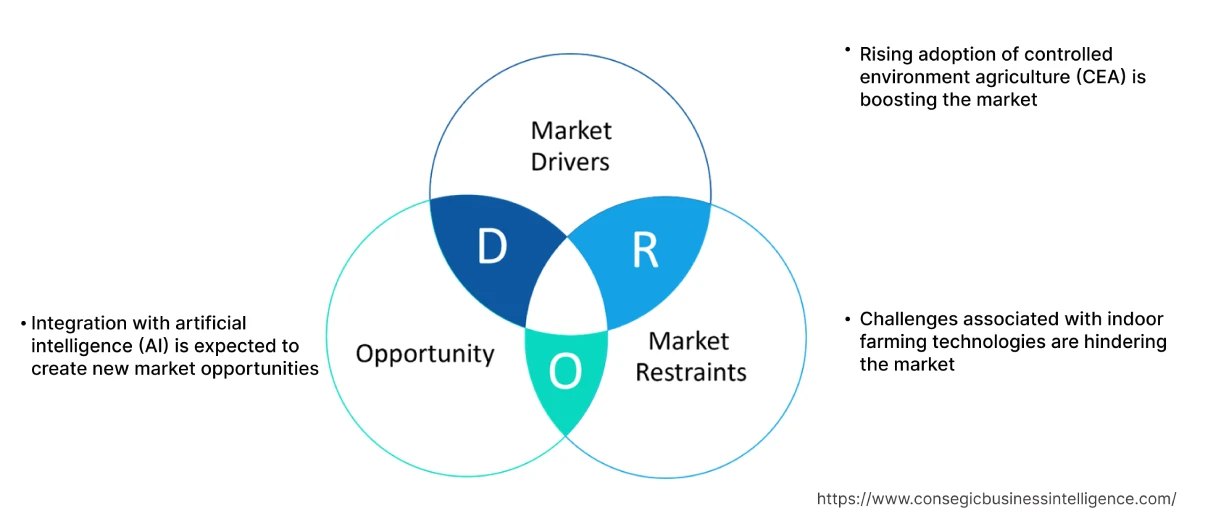- Summary
- Table Of Content
- Methodology
Indoor Farming Technology Market Size:
Indoor Farming Technology Market size is estimated to reach over USD 41.15 Billion by 2032 from a value of USD 20.98 Billion in 2024 and is projected to grow by USD 22.46 Billion in 2025, growing at a CAGR of 9.6% from 2025 to 2032.
Indoor Farming Technology Market Scope & Overview:
Indoor farming utilizes various technologies to create controlled environments for plant growth, maximizing yield and efficiency. Key technologies include vertical farming, hydroponics, and aeroponics, which allow space optimization, resource conservation, and year-round production. These technologies are further enhanced by automation, precision agriculture, and climate control systems, enabling precise management of environmental factors such as temperature, humidity, and light.
Key Drivers:
Rising adoption of controlled environment agriculture (CEA) is boosting the market
CEA systems shield crops from extreme weather conditions including harsh winds, heavy rainfall, and temperature fluctuations, ensuring consistent and reliable crop production, particularly during unfavorable seasons. This protection also minimizes the risk of damage from pests and diseases, reducing the need for chemical interventions and leading to cleaner, healthier produce. CEA allows precise control over various environmental factors, such as temperature, humidity, light levels, and carbon dioxide concentrations, which directly impact plant growth and development. By optimizing these factors, CEA can extend the growing season, produce crops out of season, and even cultivate crops that would not thrive in traditional outdoor settings.
- For instance, in October 2024, Kinghaven Farms expanded its business by the launch of Haven Greens. Haven Greens is a brand focused on controlled environment agriculture.
Thus, the aforementioned factors are boosting the usage of controlled environment agriculture, in turn driving the indoor farming technology market growth.
Key Restraints:
Challenges associated with indoor farming technologies are hindering the market
Setting up an indoor farming operation requires significant investment in infrastructure, technology, and equipment, making it financially challenging for many potential farmers. Maintaining the controlled environment and specialized equipment requires considerable energy consumption, labor, and ongoing maintenance costs. Artificial lighting, climate control systems, and other automated systems consume substantial energy, potentially offsetting some of the environmental benefits of indoor farming.
Moreover, the enclosed environment of indoor farming can pose challenges for pollination, requiring manual pollination or alternative methods that can be costly and time-consuming. Thus, the market analysis shows that the aforementioned factors are restraining the indoor farming technology market demand.
Future Opportunities :
Integration with artificial intelligence (AI) is expected to create new market opportunities
Indoor farming technology, when combined with AI, offers advantages like optimized resource use, increased efficiency, and improved crop health. AI helps to optimize water, fertilizer, and energy usage, leading to reduced waste and lower costs. AI monitors crop health in real-time, detects diseases early, and optimizes environmental conditions for optimal growth. Moreover, AI is able to automate tasks including irrigation, pest control, and harvesting, leading to increased efficiency and reduced labor costs.
- For instance, in November 2024, Forth Growers, a robotic startup, secured a USD 9 million. The startup aims to scale AI and robotics solutions, to drive high-quality, sustainable, and affordable food production worldwide.
Thus, the ongoing advancements are projected to drive indoor farming technology market opportunities during the forecast period.
Indoor Farming Technology Market Segmental Analysis :
By Type:
Based on the type, the market is segmented into vertical farming, containerized farming, plant factories, rooftop farming, and controlled environment agriculture (CEA).
Trends in the Type:
- Rising adoption of plant factories for year-round, consistent production, reduced reliance on pesticides, and increased efficiency in water and resource use.
- Increasing demand for containerized farming due to its several benefits including increased yields in smaller spaces and enhanced pest and disease control.
The vertical farming segment accounted for the largest revenue share in the market in 2024.
- Vertical farms produce more food in a smaller space, using significantly less water and land as compared to traditional farming.
- Controlled environments allow consistent crop production regardless of season or weather conditions.
- For instance, in January 2025, Avisomo raised USD 5.6 million for fully automated vertical farming solutions. The company aims to provide sustainable large-scale local food production.
- Therefore, the wide spread adoption of vertical farming is boosting the indoor farming technology market growth.
The rooftop farming segment is expected to register the significant CAGR during the forecast period.
- Rooftop farming offers numerous benefits including improved air quality, reduced urban heat island effect, and increased property value.
- Moreover, rooftop farming reduces the urban heat island effect, improves air quality, and helps with rainwater retention.
- Rooftop farming provides access to fresh, healthy, and locally grown food, reducing reliance on long-distance transportation and create new income streams and job opportunities, particularly in urban settings.
- Thus, the rising adoption of rooftop farming is expected to boost the indoor farming technology market trends during the forecast period.
By Growing Method:
Based on the growing method, the market is segmented into hydroponics, aeroponics, aquaponics, traditional soil-based farming, and nutrient film technique (NFT).
Trends in the Growing Method:
- Rising demand for aeroponics for faster growth and reduced water usage due to abundant oxygen supply to the roots and direct access to nutrients.
- Increasing trend in adoption of nutrient film technique for efficient nutrient and water use, improved root oxygenation, and space-saving designs.
The hydroponics segment accounted for the largest revenue in the indoor farming technology market share in 2024.
- Hydroponics is a method of growing plants without soil using nutrient-rich water. This offers advantages including increased yields, faster growth, and reduced water use.
- Hydroponic systems can produce significantly more food in less time as compared to traditional soil-based farming. Hydroponics allows vertical farming, maximizing space utilization, particularly in urban areas.
- Moreover, closed-loop systems minimize water waste by recirculating and reusing the nutrient solution.
- For instance, in December 2024, Tripura launched commercial hydroponics to boost sustainable farming. The company focuses to create at least 500 square meters setups for India.
- Therefore, the wide applications of hydroponics are boosting the indoor farming technology market demand.
The aquaponics segment is expected to register the fastest CAGR during the forecast period.
- Aquaponics is a symbiotic system combining aquaculture (raising fish) and hydroponics (growing plants without soil). It offers several benefits including reduced water usage, increased food production, and a closed-loop system.
- Aquaponics systems often require less reliance on chemical fertilizers and pesticides, as fish waste provides nutrients for plants and plants naturally filter the water for fish.
- Moreover, aquaponics is implemented in limited spaces, making it suitable for indoor or urban farming. The interconnected nature of aquaponics foster biodiversity within the system.
- Thus, the rising adoption of aquaponics in urban cities is expected to boost the indoor farming technology market trends during the forecast period.
By Crop Type:
Based on the crop type, the market is segmented into leafy greens, fruits, herbs, medicinal plants, and flowers.
Trends in the Crop Type:
- Rising demand for hydroponics and vertical farming to significantly increase herb yields and reduce growing times as compared to traditional soil-based methods.
- Increasing trend in adoption of indoor farming to eliminate reliance on weather conditions, enabling consistent production of medicinal plants throughout the year.
The leafy greens segment accounted for the largest revenue in the indoor farming technology market share in 2024.
- Leafy greens are a popular crop for indoor farming due to their short growth cycles and high nutritional value.
- Optimizing light spectra and intensities is crucial for maximizing growth and nutrient accumulation in different leafy greens.
- Indoor farming technology allows for year-round production and consistent supply of leafy greens, addressing seasonal limitations in traditional agriculture.
- Therefore, the aforementioned factors are boosting the indoor farming technology market size.
The flowers segment is expected to register the fastest CAGR during the forecast period.
- Indoor farming technology eliminates dependence on seasons and weather, enabling consistent flower availability throughout the year.
- By enabling local or regional flower production, indoor farming minimizes transportation distances and related emissions.
- Controlled environments allow for optimized growing conditions, resulting in healthier, and higher-quality flowers.
- Thus, the market analysis shows that the aforementioned factors are expected to boost the indoor farming technology market expansion during the forecast period.
By Light Source:
Based on the light source, the market is segmented into LED grow lights, fluorescent grow lights, high-pressure sodium (HPS) grow lights, metal halide (MH) grow lights, and plasma grow lights.
Trends in the Light Source:
- Rising demand for fluorescent grow lights as these lights, mimic natural sunlight, providing plants with the necessary wavelengths of light for photosynthesis.
- Increasing adoption of plasma grow lights to provide a more balanced ecosystem, leading to healthier, and more disease-resistant plants.
The LED grow lights segment accounted for the largest revenue share of 40.68% in the market in 2024 and is expected to register the fastest CAGR during the forecast period.
- LED lights consume significantly less energy as compared to traditional lighting, resulting in lower electricity costs and reduced carbon emissions.
- Indoor farming allows for precise control over light duration, intensity, and spectrum, mimicking natural sunlight or even surpassing it in effectiveness, leading to optimized plant growth.
- LED lights are tailored to emit specific wavelengths of light including red and blue, crucial for photosynthesis, leading to enhanced growth and yield.
- LEDs produce less heat than traditional lighting, minimizing stress on indoor plants and reducing the need for cooling systems, further increasing energy efficiency.
- Moreover, LEDs use far less energy than older technologies like HIDs, which reduces operating costs and the carbon footprint of farms.
- Therefore, the market analysis shows that the wide spread adoption of LED grow lights is boosting the indoor farming technology market size.

By Environmental Control Systems:
Based on the environmental control systems, the market is segmented into temperature control systems, humidity control systems, CO2 control systems, water management systems, and nutrient delivery systems.
Trends in the Environmental Control Systems:
- Rising demand for CO2 control systems to help maintain balanced environmental conditions and increase the efficiency of photosynthesis.
- Increasing adoption of humidity control systems for optimizing plant growth and preventing diseases.
The nutrient delivery systems segment accounted for the largest revenue share in the market in 2024.
- In indoor farming, nutrient delivery systems provide essential nutrients to plants in controlled environments, including hydroponics and aeroponics.
- These systems typically involve injecting or transporting water-soluble nutrients into the irrigation water before it reaches the plants.
- They also monitor other factors including pH, electrical conductivity (EC), and water temperature.
- Moreover, these systems ensure that plants receive the correct balance of essential nutrients for optimal growth, which includes macronutrients including nitrogen, phosphorus, and potassium, as well as micronutrients.
- Furthermore, by delivering nutrients directly to the roots, these systems minimize nutrient waste and improve resource utilization compared to traditional soil-based agriculture.
- Therefore, the indoor farming technology market analysis shows that the aforementioned factors are boosting the market expansion.
The temperature control systems segment is expected to register the fastest CAGR during the forecast period.
- Temperature control systems in indoor farming maintain optimal growing conditions by regulating air and water temperatures, influencing factors like plant health, growth rates, and yields.
- These systems use sensors to monitor temperature and then employ various methods, including heating, cooling, and ventilation, to achieve desired temperature ranges.
- Moreover, temperature sensors monitor air and water temperatures, providing feedback to the control system. Meanwhile, control units regulate the operation of heating, cooling, and ventilation systems based on sensor data.
- Thus, the market analysis depicts that the aforementioned factors are expected to boost the indoor farming technology market opportunities during the forecast period.
Regional Analysis:
The regions covered are North America, Europe, Asia Pacific, the Middle East and Africa, and Latin America.

Asia Pacific region was valued at USD 6.04 Billion in 2024. Moreover, it is projected to grow by USD 6.49 Billion in 2025 and reach over USD 12.38 Billion by 2032. Out of this, China accounted for the maximum revenue share of 35.18%. The market in the Asia Pacific region is growing due to rising adoption of indoor farming technologies including soil-based farming and hydroponics in urban cities. Moreover, there is an increasing trend in adoption of vertical farming for growing vegetables, fruits, herbs, and flowers in compact spaces, thereby, boosting the market.
- For instance, in February 2022, Government of Sikkim (State in India), announced the launch of modern technologies including aquaponics, hydroponics, and rooftop farming. The departments developed four models including both low cost and high-cost models at the premises.

North America is estimated to reach over USD 14.03 Billion by 2032 from a value of USD 7.30 Billion in 2024 and is projected to grow by USD 7.80 Billion in 2025. The market is primarily driven due to wide spread adoption of hydroponics and aquaponics technologies in the North American region. Moreover, rising government investments in farming technology industry are also driving the market in the region.
- For instance, in October 2025, S. Department of Agriculture (USDA) invested USD 9 million in 10 organizations for urban farming. This program is expected to provide education, outreach, and technical assistance to indoor agricultural producers in urban areas.
The indoor farming technology market analysis shows that the market in Europe is growing due to rising adoption of vertical farming for producing fruits and flowers among others. In Latin America, Middle East, and Africa, the market is primarily driven due to the rising urbanization, which is boosting the need for vertical farming and roof top farming for year-around production. This is driving the indoor farming technology market expansion in the region.
Top Key Players and Market Share Insights:
The indoor farming technology industry is highly competitive with major players providing solutions to the national and international markets. Key players are adopting several strategies in research and development (R&D), product innovation, and end-user launches to hold a strong position in the global indoor farming technology market. Key players in the indoor farming technology industry include -
- AeroFarms (US)
- AppHarvest (US)
- Bowery Farming (US)
- BrightFarms (US)
- FreshBox Farms (US)
- Jones Food Company (UK)
- Kalera (US)
- Lettuce Grow (US)
- Plenty (US)
- Vertical Field Farms (Israel)
Recent Industry Developments :
Collaborations and Partnerships:
- In August 2024, Metro Turkey collaborated with Hatko Aquaculture and Alpha Aqua to develop an aquaponics facility. The facility aims to cultivate sea bass using a recirculating aquaculture system.
Indoor Farming Technology Market Report Insights :
| Report Attributes | Report Details |
| Study Timeline | 2019-2032 |
| Market Size in 2032 | USD 41.15 Billion |
| CAGR (2025-2032) | 9.6% |
| By Type |
|
| By Component |
|
| By Application |
|
| By End-User |
|
| By Region |
|
| Key Players |
|
| North America | U.S. Canada Mexico |
| Europe | U.K. Germany France Spain Italy Russia Benelux Rest of Europe |
| APAC | China South Korea Japan India Australia ASEAN Rest of Asia-Pacific |
| Middle East and Africa | GCC Turkey South Africa Rest of MEA |
| LATAM | Brazil Argentina Chile Rest of LATAM |
| Report Coverage |
|
Key Questions Answered in the Report
How big is the indoor farming technology market? +
Indoor Farming Technology Market size is estimated to reach over USD 41.15 Billion by 2032 from a value of USD 20.98 Billion in 2024 and is projected to grow by USD 22.46 Billion in 2025, growing at a CAGR of 9.6% from 2025 to 2032.
What are the major segments covered in the indoor farming technology market report? +
The segments covered in the report are type, growing method, crop type, light source, environmental control systems, and region.
Which region holds the largest revenue share in 2024 in the indoor farming technology market? +
North America holds the largest revenue share in the indoor farming technology market in 2024.
Who are the major key players in the indoor farming technology market? +
The major key players in the market are AeroFarms (US), AppHarvest (US), Bowery Farming (US), BrightFarms (US), FreshBox Farms (US), Jones Food Company (UK), Kalera (US), Lettuce Grow (US), Plenty (US), Vertical Field Farms (Israel), and others.


